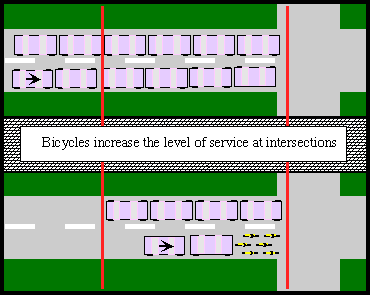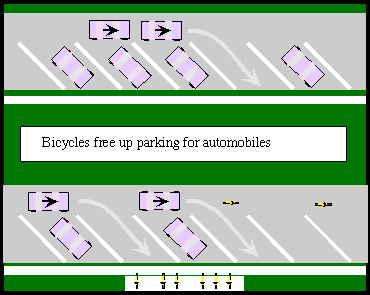|
1 Introduction
| contents: |
Traffic congestion in the U.S. has continually worsened during the later half of the 20th century and is expected to worsen even more quickly during the early part of the 21th century. Alternatives to driving are badly needed if there is to be any hope of reducing this problem, and encouraging cycling is an effective, low cost approach. Bicycles and automobiles have to share the same roads and, unfortunately, some drivers have a hostile attitude towards cycling which manifests itself in a variety of ways ranging from rude behavior (unnecessary honking, etc.) to, in a few cases, outright vehicular assault.
Part of the hostility is due to a misperception that bicycles "delay traffic" and part is due to a lack of understanding of traffic laws and a lack of driving skill. Both are addressed in what follows.
Bicycling and Traffic Delays
Contrary to popular myth, increases in cycling for transportation purposes is actually in the best interest of drivers because it helps decrease delays. While many drivers think of delay as being caused by slower moving vehicles or bicycles ahead, in fact the dominant factor slowing travel is inadequate capacity at intersections.
In fact, as the next figure shows, as people switch from driving to cycling, delays go down, not up. In the figure, the top half shows cars waiting at a red light. The cars behind the right most red line will get through the intersection on the next green phase and the cars behind the left red line will not. The bottom half of the figure shows what happens if some of the cars are replaced with bicycles.

The last car to arrive at the intersection (the one with the arrow on it) will get through the intersection on the next green light when following a group of bicycles, but would not if those cyclists drove instead. As drawn, the cyclists have formed a group to move as many people though the intersection as possible just after the light changes. A few seconds later, the cyclists (who will typically be riding at different speeds), will sort themselves out into a straight line, allowing cars to pass. When accelerating from 0 to about 10 mph, cyclists can match the acceleration of average motorists, so the time spend merging to the right does not delay following drivers any more than a car would, and delays following drivers far less than a similar number of automobiles would.
Bicycling and Parking
Bicyclist do not compete with cars for parking. As illustrated in the next figure, the more cyclists there are, the easier it is to find parking. The top half shows what happens if everyone drives: if someone is lucky enough to find a parking slot, it is probably going to be someone else. The bottom figure shows what happens when more people cycle: there is more parking for everyone, primarily because bicycles need little space to park, so it is easier to meet demand.

Note that the few seconds of delay you might attribute to bicycles is more than paid for by the several additional minutes spent looking for a parking slot. Unfortunately, bicycle parking is not always a priority, which discourages cycling for short utilitarian trips. This lack of foresight is also expensive: a parking slot for a motor vehicle costs anywhere from a few thousand dollars in a simple asphalt lot to over $20,000 per vehicle in a multilevel garage.
Safety
With the advantages cited above, you would think that drivers would want to encourage cycling as it is in the best interests of drivers. Unfortunately, at the time this was written (1999), some drivers are actively hostile towards cyclists and go out of their way to harass cyclists. Other drivers are simply ignorant of what to do and end up inconveniencing themselves as a result. This inconvenience can be significantly reduced by following some simple rules.
The basic rule is to treat bicycles like any other vehicle, being extra careful because cyclists are not surrounded by a passenger compartment that can offer some protection in an accident. The details, including traffic rules, expected cyclist behavior, and hints on accident avoidance are provided in the following sections.
Example of Motorist Errors
The following shows how drivers sometimes make life difficult for themselves and other drivers when passing cyclists, and is a good illustration of both a common problem and why better driver education is needed.
 |
|
Naturally, the drivers in the right frames will attribute their delay to the cyclist, even though the delay was in fact caused by one of the drivers violating one or more traffic laws. The authors hope that the suggestions in this document will help avoid such misunderstandings and reduce delays as a result.
|
